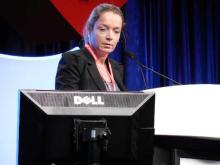NASHVILLE, TENN.– Results from several trials recently showed that endovascular therapy can improve long-term stroke outcome substantially, compared with conventional intravenous thrombolytic therapy. A new analysis from one of those studies now shows how time sensitive this benefit is, further underscoring the importance of rapid treatment for patients with acute ischemic stroke.
A delay of just an hour or 2 in the time to reperfusion of the blocked cerebral blood supply had a substantial impact on the added efficacy of intra-arterial therapy for improving long-term clinical outcome in MR CLEAN, a Dutch study with 500 acute ischemic stroke patients randomized to intra-arterial therapy or intravenous thrombolysis.
When only 2 hours elapsed from the time of stroke onset to the time of reperfusion, patients enrolled in the MR CLEAN (Multicenter Randomized Clinical Trial of Endovascular Treatment for Acute Ischemic Stroke in the Netherlands) study who received intra-arterial therapy had a 33% higher rate of scoring 0-2 on the modified Rankin scale at 90 days after stroke onset (an indication of either no or limited long-term disability), compared with patients on intravenous thrombolytic therapy. In contrast, when 6 hours elapsed from the time of stroke onset to reperfusion the incremental benefit from intra-arterial treatment dropped to 6.5%, a statistically significant decline in the treatment effect, Dr. Puck S.S. Fransen said at the International Stroke Conference.
In other words, for every 1-hour delay in time to reperfusion after 2 hours out from stroke onset, there was about a 7% drop in added advantage of intra-arterial therapy over standard therapy, reinforcing the need to start intra-arterial therapy and produce reperfusion as quickly as possible in qualifying patients, said Dr. Fransen, a researcher in the department of neurology at Erasmus University in Rotterdam, the Netherlands.
The overall benefit from intra-arterial therapy over standard treatment in MR CLEAN was a 13.5% improvement in patients having a good outcome by modified Rankin score after 90 days. By adjusted odds ratio analysis intra-arterial treatment produced a good outcome about twice as often as conventional treatment with intravenous thrombolysis.
Her analysis also showed that when patients started receiving intra-arterial therapy after more than 6 hours had elapsed from stroke onset its added benefit compared with thrombolysis became statistically insignificant, essentially disappearing.
“Delay to reperfusion is costly to the individual patient; that is the message,” commented Dr. Joseph P. Broderick, professor of neurology and director of the Neuroscience Institute at the University of Cincinnati.
MR CLEAN’s primary aim compared the efficacy and safety of intra-arterial therapy (with intra-arterial thrombolysis, intra-arterial thrombectomy, or both) vs. standard treatment with intravenous thrombolysis in 500 patients with a proximal occlusion in a large intracerebral artery seen at any of 16 Dutch centers. The primary endpoint showed a statistically significant improvement in outcomes with interventional therapy as measured by the modified Rankin scale at 90 days (N. Engl. J. Med. 2015;372:11-20).
Dr. Fransen’s new analysis divided the 500 patients in the study into tertiles based on their time to treatment, and in a second analysis based on their time to reperfusion, defined as achieving a Thrombolysis in Cerebral Infarction blood flow score of 2b or 3 or the end of the procedure when a TICI at this level did not occur.
Among MR CLEAN patients, the median time to reperfusion was 332 min (about 5.5 hours), with only about 1% of patients reperfused less than 3 hours after stroke onset, 22% reperfused 3-4.5 hours after onset, 40% reperfused 4.5-6 hours after onset, and 37% reperfused after more than 6 hours.
While the relationship between time to reperfusion and a higher rate of benefit from intra-arterial treatment reached statistical significance, the analysis of time to treatment and 90-day outcome failed to show a significant difference, Dr. Fransen said. But the trend went in the same direction. Patients treated in the first 2 hours after stroke onset had a 19% added benefit from intra-arterial therapy, while those not treated until 6 hours out from onset received a 3% incremental benefit from intra-arterial therapy compared with intravenous thrombolysis.
On Twitter @mitchelzoler



